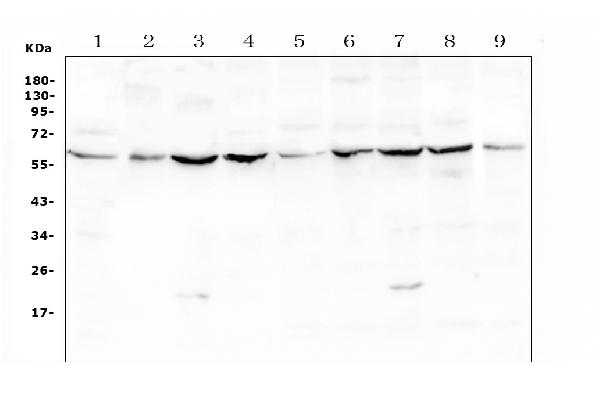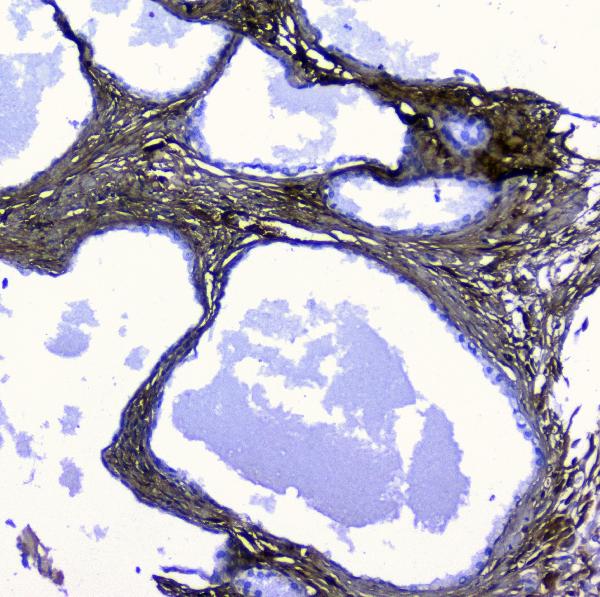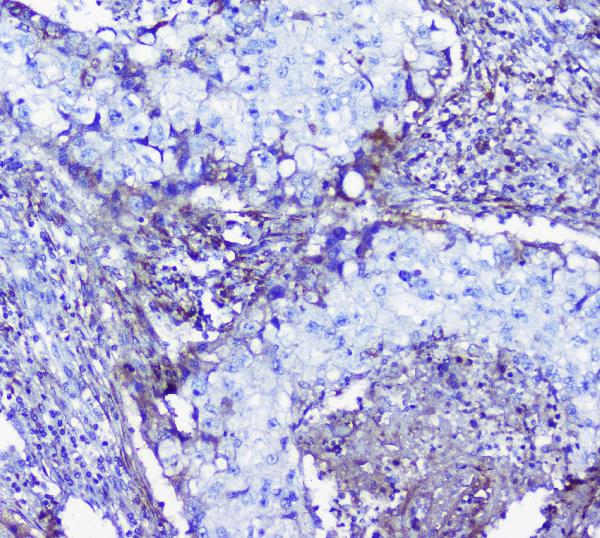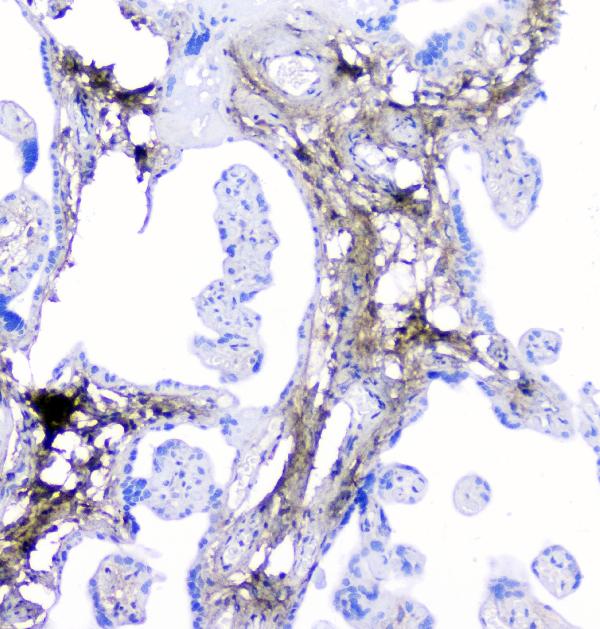Product Info Summary
| SKU: | A01034-1 |
|---|---|
| Size: | 100 μg/vial |
| Reactive Species: | Human, Mouse, Rat |
| Host: | Rabbit |
| Application: | ELISA, IHC, WB |
Customers Who Bought This Also Bought
Product info
Product Name
Anti-Lumican Antibody Picoband®
SKU/Catalog Number
A01034-1
Size
100 μg/vial
Form
Lyophilized
Description
Boster Bio Anti-Lumican Antibody Picoband® catalog # A01034-1. Tested in ELISA, IHC, WB applications. This antibody reacts with Human, Mouse, Rat. The brand Picoband indicates this is a premium antibody that guarantees superior quality, high affinity, and strong signals with minimal background in Western blot applications. Only our best-performing antibodies are designated as Picoband, ensuring unmatched performance.
Storage & Handling
Store at -20˚C for one year from date of receipt. After reconstitution, at 4˚C for one month. It can also be aliquotted and stored frozen at -20˚C for six months. Avoid repeated freeze-thaw cycles.
Cite This Product
Anti-Lumican Antibody Picoband® (Boster Biological Technology, Pleasanton CA, USA, Catalog # A01034-1)
Host
Rabbit
Contents
Each vial contains 4mg Trehalose, 0.9mg NaCl, 0.2mg Na2HPO4, 0.05mg NaN3.
Clonality
Polyclonal
Isotype
Rabbit IgG
Immunogen
E. coli-derived human Lumican recombinant protein (Position: A50-N338).
*Blocking peptide can be purchased. Costs vary based on immunogen length. Contact us for pricing.
Cross-reactivity
No cross-reactivity with other proteins.
Reactive Species
A01034-1 is reactive to LUM in Human, Mouse, Rat
Reconstitution
Add 0.2ml of distilled water will yield a concentration of 500ug/ml.
Observed Molecular Weight
58 kDa
Calculated molecular weight
38.429kDa
Background of Lumican
Lumican, also known as LUM, is an extracellular matrix protein that, in humans, is encoded by the LUM gene on chromosome 12. Lumican is a major keratan sulfate proteoglycan of the cornea but is ubiquitously distributed in most mesenchymal tissues throughout the body. And Lumican is involved in collagen fibril organization and circumferential growth, corneal transparency, and epithelial cell migration and tissue repair. Corneal transparency is possible due to the exact alignment of collagen fibers by lumican (and keratocan) in the intrafibrillar space.
Antibody Validation
Boster validates all antibodies on WB, IHC, ICC, Immunofluorescence, and ELISA with known positive control and negative samples to ensure specificity and high affinity, including thorough antibody incubations.
Application & Images
Applications
A01034-1 is guaranteed for ELISA, IHC, WB Boster Guarantee
Assay Dilutions Recommendation
The recommendations below provide a starting point for assay optimization. The actual working concentration varies and should be decided by the user.
Western blot, 0.1-0.5μg/ml
Immunohistochemistry (Paraffin-embedded Section), 0.5-1μg/ml
ELISA, 0.1-0.5μg/ml
Positive Control
WB: human placenta tissue, human Caco-2 whole cell, human CCRF-CEM whole cell, human Hela whole cell, human Jurkat whole cell, mouse liver tissue, mouse ovary tissue, mouse testis tissue, mouse lung tissue, rat liver tissue, rat ovary tissue, rat testis tissue, rat lung tissue, rat heart tissue
IHC: human ovary cancer tissue, human pancreatic cancer tissue, human lung cancer tissue, human placenta tissue
Validation Images & Assay Conditions

Click image to see more details
Figure 1. Western blot analysis of Lumican using anti-Lumican antibody (A01034-1).
Electrophoresis was performed on a 5-20% SDS-PAGE gel at 70V (Stacking gel) / 90V (Resolving gel) for 2-3 hours. The sample well of each lane was loaded with 50ug of sample under reducing conditions.
Lane 1: human placenta tissue lysates,
Lane 2: human Caco-2 whole cell lysate,
Lane 3: human CCRF-CEM whole cell lysate,
Lane 4: human Hela whole cell lysate,
Lane 5: human Jurkat whole cell lysate.
After Electrophoresis, proteins were transferred to a Nitrocellulose membrane at 150mA for 50-90 minutes. Blocked the membrane with 5% Non-fat Milk/ TBS for 1.5 hour at RT. The membrane was incubated with rabbit anti-Lumican antigen affinity purified polyclonal antibody (Catalog # A01034-1) at 0.5 μg/mL overnight at 4°C, then washed with TBS-0.1%Tween 3 times with 5 minutes each and probed with a goat anti-rabbit IgG-HRP secondary antibody at a dilution of 1:10000 for 1.5 hour at RT. The signal is developed using an Enhanced Chemiluminescent detection (ECL) kit (Catalog # EK1002) with Tanon 5200 system. A specific band was detected for Lumican at approximately 58KD. The expected band size for Lumican is at 38KD.

Click image to see more details
Figure 2. Western blot analysis of Lumican using anti-Lumican antibody (A01034-1).
Electrophoresis was performed on a 5-20% SDS-PAGE gel at 70V (Stacking gel) / 90V (Resolving gel) for 2-3 hours. The sample well of each lane was loaded with 50ug of sample under reducing conditions.
Lane 1: mouse liver tissue lysates,
Lane 2: mouse ovary tissue lysates,
Lane 3: mouse testis tissue lysates,
Lane 4: mouse lung tissue lysates,
Lane 5: rat liver tissue lysates,
Lane 6: rat ovary tissue lysates,
Lane 7: rat testis tissue lysates,
Lane 8: rat lung tissue lysates,
Lane 9: rat heart tissue lysates.
After Electrophoresis, proteins were transferred to a Nitrocellulose membrane at 150mA for 50-90 minutes. Blocked the membrane with 5% Non-fat Milk/ TBS for 1.5 hour at RT. The membrane was incubated with rabbit anti-Lumican antigen affinity purified polyclonal antibody (Catalog # A01034-1) at 0.5 μg/mL overnight at 4°C, then washed with TBS-0.1%Tween 3 times with 5 minutes each and probed with a goat anti-rabbit IgG-HRP secondary antibody at a dilution of 1:10000 for 1.5 hour at RT. The signal is developed using an Enhanced Chemiluminescent detection (ECL) kit (Catalog # EK1002) with Tanon 5200 system. A specific band was detected for Lumican at approximately 58KD. The expected band size for Lumican is at 38KD.

Click image to see more details
Figure 3. IHC analysis of Lumican using anti-Lumican antibody (A01034-1).
Lumican was detected in paraffin-embedded section of human ovary cancer tissue. Heat mediated antigen retrieval was performed in citrate buffer (pH6, epitope retrieval solution) for 20 mins. The tissue section was blocked with 10% goat serum. The tissue section was then incubated with 1μg/ml rabbit anti-Lumican Antibody (A01034-1) overnight at 4°C. Biotinylated goat anti-rabbit IgG was used as secondary antibody and incubated for 30 minutes at 37°C. The tissue section was developed using Strepavidin-Biotin-Complex (SABC)(Catalog # SA1022) with DAB as the chromogen.

Click image to see more details
Figure 4. IHC analysis of Lumican using anti-Lumican antibody (A01034-1).
Lumican was detected in paraffin-embedded section of human pancreatic cancer tissue. Heat mediated antigen retrieval was performed in citrate buffer (pH6, epitope retrieval solution) for 20 mins. The tissue section was blocked with 10% goat serum. The tissue section was then incubated with 1μg/ml rabbit anti-Lumican Antibody (A01034-1) overnight at 4°C. Biotinylated goat anti-rabbit IgG was used as secondary antibody and incubated for 30 minutes at 37°C. The tissue section was developed using Strepavidin-Biotin-Complex (SABC)(Catalog # SA1022) with DAB as the chromogen.

Click image to see more details
Figure 5. IHC analysis of Lumican using anti-Lumican antibody (A01034-1).
Lumican was detected in paraffin-embedded section of human lung cancer tissue. Heat mediated antigen retrieval was performed in citrate buffer (pH6, epitope retrieval solution) for 20 mins. The tissue section was blocked with 10% goat serum. The tissue section was then incubated with 1μg/ml rabbit anti-Lumican Antibody (A01034-1) overnight at 4°C. Biotinylated goat anti-rabbit IgG was used as secondary antibody and incubated for 30 minutes at 37°C. The tissue section was developed using Strepavidin-Biotin-Complex (SABC)(Catalog # SA1022) with DAB as the chromogen.

Click image to see more details
Figure 6. IHC analysis of Lumican using anti-Lumican antibody (A01034-1).
Lumican was detected in paraffin-embedded section of human placenta tissue. Heat mediated antigen retrieval was performed in citrate buffer (pH6, epitope retrieval solution) for 20 mins. The tissue section was blocked with 10% goat serum. The tissue section was then incubated with 1μg/ml rabbit anti-Lumican Antibody (A01034-1) overnight at 4°C. Biotinylated goat anti-rabbit IgG was used as secondary antibody and incubated for 30 minutes at 37°C. The tissue section was developed using Strepavidin-Biotin-Complex (SABC)(Catalog # SA1022) with DAB as the chromogen.
Protein Target Info & Infographic
Gene/Protein Information For LUM (Source: Uniprot.org, NCBI)
Gene Name
LUM
Full Name
Lumican
Weight
38.429kDa
Superfamily
small leucine-rich proteoglycan (SLRP) family
Alternative Names
Lumican; Keratan sulfate proteoglycan lumican; KSPG lumican; LUM; LDC; SLRR2D; LUM LDC, SLRR2D lumican lumican|KSPG lumican|epididymis secretory sperm binding protein|keratan sulfate proteoglycan lumican|lumican proteoglycan
*If product is indicated to react with multiple species, protein info is based on the gene entry specified above in "Species".For more info on LUM, check out the LUM Infographic

We have 30,000+ of these available, one for each gene! Check them out.
In this infographic, you will see the following information for LUM: database IDs, superfamily, protein function, synonyms, molecular weight, chromosomal locations, tissues of expression, subcellular locations, post-translational modifications, and related diseases, research areas & pathways. If you want to see more information included, or would like to contribute to it and be acknowledged, please contact [email protected].
Specific Publications For Anti-Lumican Antibody Picoband® (A01034-1)
Hello CJ!
No publications found for A01034-1
*Do you have publications using this product? Share with us and receive a reward. Ask us for more details.
Recommended Resources
Here are featured tools and databases that you might find useful.
- Boster's Pathways Library
- Protein Databases
- Bioscience Research Protocol Resources
- Data Processing & Analysis Software
- Photo Editing Software
- Scientific Literature Resources
- Research Paper Management Tools
- Molecular Biology Software
- Primer Design Tools
- Bioinformatics Tools
- Phylogenetic Tree Analysis
Customer Reviews
Have you used Anti-Lumican Antibody Picoband®?
Submit a review and receive an Amazon gift card.
- $30 for a review with an image
0 Reviews For Anti-Lumican Antibody Picoband®
Customer Q&As
Have a question?
Find answers in Q&As, reviews.
Can't find your answer?
Submit your question
7 Customer Q&As for Anti-Lumican Antibody Picoband®
Question
Is this A01034-1 anti-Lumican antibody reactive to the isotypes of LUM?
Verified Customer
Verified customer
Asked: 2020-05-06
Answer
The immunogen of A01034-1 anti-Lumican antibody is E. coli-derived human Lumican recombinant protein (Position: A50-N338). Could you tell me which isotype you are interested in so I can help see if the immunogen is part of this isotype?
Boster Scientific Support
Answered: 2020-05-06
Question
We appreciate helping with my inquiry over the phone. Here are the WB image, lot number and protocol we used for intestine placenta using anti-Lumican antibody A01034-1. Let me know if you need anything else.
Verified Customer
Verified customer
Asked: 2020-01-10
Answer
Thank you for the data. You have provided everything we needed. Our lab team are working to resolve your inquiry as quickly as possible, and we appreciate your patience and understanding! Please let me know if there is anything you need in the meantime.
Boster Scientific Support
Answered: 2020-01-10
Question
Does A01034-1 anti-Lumican antibody work on parafin embedded sections? If so, which fixation method do you recommend we use (PFA, paraformaldehyde, other)?
Verified Customer
Verified customer
Asked: 2019-11-22
Answer
It shows on the product datasheet, A01034-1 anti-Lumican antibody as been tested on ELISA. It is best to use PFA for fixation because it has better tissue penetration ability. PFA needs to be prepared fresh before use. Long term stored PFA turns into formalin, as the PFA molecules congregate and become formalin.
Boster Scientific Support
Answered: 2019-11-22
Question
I see that the anti-Lumican antibody A01034-1 works with ELISA, what is the protocol used to produce the result images on the product page?
Verified Customer
Verified customer
Asked: 2019-08-23
Answer
You can find protocols for ELISA on the "support/technical resources" section of our navigation menu. If you have any further questions, please send an email to [email protected]
Boster Scientific Support
Answered: 2019-08-23
Question
We want to test anti-Lumican antibody A01034-1 on mouse intestine placenta for research purposes, then I may be interested in using anti-Lumican antibody A01034-1 for diagnostic purposes as well. Is the antibody suitable for diagnostic purposes?
Verified Customer
Verified customer
Asked: 2019-07-11
Answer
The products we sell, including anti-Lumican antibody A01034-1, are only intended for research use. They would not be suitable for use in diagnostic work. If you have the means to develop a product into diagnostic use, and are interested in collaborating with us and develop our product into an IVD product, please contact us for more discussions.
Boster Scientific Support
Answered: 2019-07-11
Question
I was wanting to use your anti-Lumican antibody for ELISA for mouse intestine placenta on frozen tissues, but I want to know if it has been tested for this particular application. Has this antibody been tested and is this antibody a good choice for mouse intestine placenta identification?
Verified Customer
Verified customer
Asked: 2018-08-01
Answer
It shows on the product datasheet, A01034-1 anti-Lumican antibody has been tested for ELISA, IHC, WB on human, mouse, rat tissues. We have an innovator award program that if you test this antibody and show it works in mouse intestine placenta in IHC-frozen, you can get your next antibody for free.
Boster Scientific Support
Answered: 2018-08-01
Question
Would anti-Lumican antibody A01034-1 work on bovine IHC with cornea?
M. Gonzalez
Verified customer
Asked: 2015-07-30
Answer
Our lab technicians have not tested anti-Lumican antibody A01034-1 on bovine. You can run a BLAST between bovine and the immunogen sequence of anti-Lumican antibody A01034-1 to see if they may cross-react. If the sequence homology is close, then you can perform a pilot test. Keep in mind that since we have not validated bovine samples, this use of the antibody is not covered by our guarantee. However we have an innovator award program that if you test this antibody and show it works in bovine cornea in IHC, you can get your next antibody for free.
Boster Scientific Support
Answered: 2015-07-30





